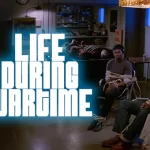**½/**** Image B+ Sound B+ Extras B
starring George Raft, Ann Sheridan, Ida Lupino, Humphrey Bogart
screenplay by Jerry Wald & Richard Macaulay
directed by Raoul Walsh
by Bill Chambers At first an earnest but cheerful portrait of two brothers trying to make ends meet as Depression-era truckers, Raoul Walsh’s They Drive By Night does a complete about-face in terms of tone about halfway through that’s almost guaranteed to cause intellectual whiplash. It might therefore be an effective salve to think of this sea change as analogous to our road-bound heroes’ plight, but it’s business as usual for both distributor Warner Bros. (here combining two disparate pieces of source material–A.I. Bezzerides’s novel The Long Haul and the 1935 Bette Davis vehicle Bordertown–simply to get mileage out of pre-owned properties) and Walsh, since Walsh seemed to gravitate towards cross-pollinated screenplays. (I’m thinking of his Pursued, a western that flirts haphazardly (yet rewardingly) with noir conventions, or his gangsters-go-camping yarn High Sierra (written by John Huston).) Nevertheless, the film’s U-turn is so radical that it arguably transforms They Drive By Night into one of the U.S. cinema’s earliest experiments in portmanteau–adequate absolution, really, for this borderline social-conscience picture’s zany mutation into a gothic melodrama.
George Raft and Humphrey Bogart star as Joe and Paul Fabrini. In the simplest terms, Joe is the go-getter and Paul is literally along for the ride: Paul is not known for staying awake on their long drives in a truck they’ve yet to pay off. Every day consists of pursuing the transportation equivalent of the mother lode–that one big haul that will seal their success–while avoiding any accidents that would similarly spell their fate. George is a bit of a womanizer, but when he hits it off with feisty ex-waitress Cassie (Ann Sheridan), he’s ready to settle down; Paul has a wife back home pressuring him to get her pregnant, and let’s just say the movie has a habit of granting its female characters exactly what they wish for with unusual disregard for the free will of Joe, Paul, and people like Ed Carlsen (Alan Hale), husband to a woman, Lana (Ida Lupino, later Hale Jr.’s director on several episodes of “Gilligan’s Island”), who considers herself one of Joe’s old flames and still carries an Olympic-size torch for him.
As Paul, Bogart is emasculated on-screen in more ways than one. First, he’s gimped-up to satisfy the didacticism of the time (with the trucking industry presenting limited opportunity for a moral, the movie settles on putting the fear of God in us over falling asleep at the wheel), then his role is reduced to reaction shots: When Paul finally takes the stand in the courtroom climax, all Bogart manages to squeeze out is “Wull yeah, but…” This is Raft’s show, despite the film’s studio-sanctioned absorption into the Bogey canon, though Bogart would have his revenge by stealing the lead in High Sierra–and in theory, every one of his Midas-touched career opportunities subsequent to High Sierra–out from under him. Raft is his dependably slick self in They Drive By Night, if finally too impassive for someone whose life is a bit of a whirligig–a peculiar side-effect of his efforts to downplay the tough guy image he’d cultivated in films like Scarface. It could be argued that each actor is ultimately miscast, with Lupino faring the best, or at least most indelibly, of the four leads.
The Code-skirting Forties dialogue is musical to modern ears (“[The boss] was always trying to pull my apron strings,” Cassie says by way of explanation for leaving her job; “There’s nothing wrong with that,” a listener offers, to which Cassie replies, “There is if you’re not wearing any apron”), as is often the case, and the aforementioned elbow in the picture, for all its conspicuousness, is probably the one reason besides Bogey that They Drive By Night has not faded into obscurity. Without spoiling too much, the switch in settings from a world of us vs. them to a more corporate-driven environment gives us something to chew on: The shift to a less individualized (i.e., more secure) milieu has resonance in that it suggests that They Drive By Night is actually an allegory of the American Dream circa the post-industrial twentieth century–our conscious or unconscious endeavouring to sell out. Of course, while this is echoed in the sensationalistic resolution to a not otherwise pandering tale, calling the film self-aware, nay, satirical, would create a whole ‘nother set of false expectations.
THE DVD
Warner’s DVD release of They Drive By Night contains a fullscreen, black-and-white transfer derived from decent resources. The first half of the film looks grittier than the second by design; I would rate the overall image on a par with Treasure of the Sierra Madre but say that it falls short of Casablanca‘s unnerving sheen. The print itself is cleaner than those acquainted with They Drive By Night through television airings will expect. Unfortunately, the attendant 1.0 mono audio sounds a bit muffled–absent is the clarity of Warner’s best centre-channel tracks (Casablanca again). Extras include the Kurtti-Pellerin retrospective “Divided Highway: The Story of They Drive By Night” (11 mins.), in which the film’s similarity to Bordertown is illustrated via clips and cinema historians Leonard Maltin, Robert Osborne, and Eric Lax recount where They Drive By Night‘s key players were in their careers at the time of production. Also on board is Crane Wilbur’s 1938 Technicolor short Swingtime in the Movies (19 mins.), a goof on backlot filmmaking and the studio system that would appear to have little relevance to the subject at hand aside from a Bogart cameo. They Drive By Night‘s theatrical trailer rounds out the disc.
95 minutes; NR; 1.33:1; English DD 1.0; CC; English, French, Spanish subtitles; DVD-9; Region One; Warner






